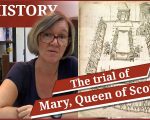On this day in history, 14th October 1586, the trial of Mary, Queen of Scots, began at Fotheringhay Castle in Northamptonshire. Historian John Guy, author of My Heart is My Own: The Life of Mary Queen of Scots, has written a brilliant chapter on Mary’s downfall, “Nemesis”, and I have him to thank for the information in this article.
Mary Queen of Scots had, at first, refused to appear before Elizabeth I’s commission, but had been told by William Cecil that the trial would take place with or without her. She appeared in front of the commission at 9am, dressed in a black velvet gown and a white cambric cap and veil. Mary then protested against the commission, arguing that the court was not legitimate and arguing against the fact that she was not allowed legal defence and was not able to call any witnesses. Mary was also not permitted to examine any of the documents being used against her. Her protests were in vain and the prosecution went ahead and opened the trial with an account of the Babington Plot, arguing that Mary knew of the plot, had given it her approval, agreed with it and had promised to help. Mary protested her innocence:
[Read More...]




